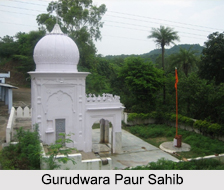 Gurudwara Paur Sahib is situated near Guru Ka Lahore and is related to Guru Gobind Singh. It is located at the village Basantpur of Bilaspur District, Himachal Pradesh. There is a small domed room with a verandah in front of Gurudwara Paur Sahib, also there is a spring which name is said to be based on a legend similar to the one related to Gurdwara Triveni Sahib. It is situated at the border of Himachal Pradesh, only 12 kilometres away from Shri Anandpur Sahib.
Gurudwara Paur Sahib is situated near Guru Ka Lahore and is related to Guru Gobind Singh. It is located at the village Basantpur of Bilaspur District, Himachal Pradesh. There is a small domed room with a verandah in front of Gurudwara Paur Sahib, also there is a spring which name is said to be based on a legend similar to the one related to Gurdwara Triveni Sahib. It is situated at the border of Himachal Pradesh, only 12 kilometres away from Shri Anandpur Sahib.
Legends of Gurudwara Paur Sahib
According to legends, it is said that a spring was formed by stomping of the `paur` (hoof) of the horse of the Guru Gobind Singh; hence the name of the Gurudwara is named Gurudwara Paur Sahib.
This article is a stub. You can enrich by adding more information to it. Send your Write Up to content@indianetzone.com.





















